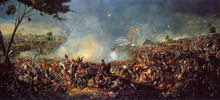| Late Cenozoic Ice Age 33.9 million years ago to present Divisions within the current ice age For divisions prior to 33.9 million years ago, see Geologic time scale | ||
| Period | Epoch | Age |
|---|---|---|
| ↑ Paleogene | Oligocene 33.9 to 23.03 Ma (last epoch of the Paleogene Period)  |
Rupelian 33.9 to 27.82 Ma |
| Chattian 27.82 to 23.03 Ma | ||
| Neogene | Miocene 23.03 to 5.333 Ma  |
Aquitanian 23.03 to 20.44 Ma |
| Burdigalian 20.44 to 15.97 Ma | ||
| Langhian 15.97 to 13.82 Ma | ||
| Serravallian 13.82 to 11.63 Ma | ||
| Tortonian 11.63 to 7.246 Ma | ||
| Messinian 7.246 to 5.333 Ma | ||
| Pliocene 5.333 to 2.58 Ma  |
Zanclean 5.333 to 3.6 Ma | |
| Piacenzian 3.6 to 2.58 Ma | ||
| Quaternary | Pleistocene 2.58 Ma to 11.7 ka[1][a]  |
Gelasian 2.58 to 1.8 Ma |
| Calabrian 1.8 Ma to 781 ka[1][4] | ||
| Middle Pleistocene ("Chibanian") ("Ionian") 781 to 126 ka[1] | ||
| Upper/Late Pleistocene ("Tarantian") 126 to 11.7 ka[1] | ||
| Holocene 11.7 ka to present[1][a]  |
Greenlandian 11.7 to 8.2 ka[1] | |
| Northgrippian 8.2 to 4.2 ka[1] | ||
| Meghalayan 4.2 ka to present[1] | ||
|
The Late Cenozoic Ice Age falls within the Cenozoic Era which started 66 million years ago. The Cenozoic Era is part of the Phanerozoic Eon which started 541 million years ago.
| ||
The Late Cenozoic Ice Age,[5][6] or Antarctic Glaciation,[7][8] began 34 million years ago at the Eocene-Oligocene Boundary and is ongoing.[5] It is Earth's current ice age or icehouse period. Its beginning is marked by the formation of the Antarctic ice sheets.[9]
Six million years after the start of the Late Cenozoic Ice Age, the East Antarctic Ice Sheet had formed, and 14 million years ago it had reached its current extent.[10]
In the last three million years, glaciations have spread to the northern hemisphere. It commenced with Greenland becoming increasingly covered by an ice sheet in late Pliocene (2.9-2.58 Ma ago)[11] During the Pleistocene Epoch (starting 2.58 Ma ago), the Quaternary glaciation developed with decreasing mean temperatures and increasing amplitudes between glacials and interglacials. During the glacial periods of the Pleistocene, large areas of northern North America and northern Eurasia have been covered by ice sheets.

- ^ a b c d e f g h "2020/3 Geologic Time Scale" (PDF). International Commission on Stratigraphy.
- ^ de Blij, Harm (2012-08-17). "Holocene Humanity". Why Geography Matters: More Than Ever. Oxford University Press. ISBN 9780199977253.
- ^ "Neogene HSU NHM". Humboldt State University.
- ^ "Calabrian Stage". Encyclopedia Britannica.
- ^ a b Dr. David E. Pitts. "Disasters Class Notes - Chapter 12: Climate Change". University of Houston-Clear Lake. Archived from the original on 16 August 2021. Retrieved 31 December 2020.
- ^ National Academy of Sciences - The National Academies Press - Continental Glaciation through Geologic Times https://www.nap.edu/read/11798/chapter/8#80
- ^ Kvasov, D.D.; Verbitsky, M.Ya. (2017). "Causes of Antarctic Glaciation in the Cenozoic". Quaternary Research. 15: 1–17. doi:10.1016/0033-5894(81)90110-1. S2CID 129673672.
- ^ Goldner, A.; Herold, N.; Huber, M. (2014). "Antarctic glaciation caused ocean circulation changes at the Eocene–Oligocene transition". Nature. 511 (7511): 574–577. Bibcode:2014Natur.511..574G. doi:10.1038/nature13597. PMID 25079555. S2CID 4460503.
- ^ "8". Continental Glaciation through Geologic Times. 1982. p. 80. doi:10.17226/11798. ISBN 978-0-309-03329-9.
{{cite book}}:|journal=ignored (help) - ^ Cite error: The named reference
rapidwas invoked but never defined (see the help page). - ^ Bartoli, G; Sarnthein, M; Weinelt, M; Erlenkeuser, H; Garbe-Schönberg, D; Lea, D.W (2005). "Final closure of Panama and the onset of northern hemisphere glaciation". Earth and Planetary Science Letters. 237 (1–2): 33–44. Bibcode:2005E&PSL.237...33B. doi:10.1016/j.epsl.2005.06.020.